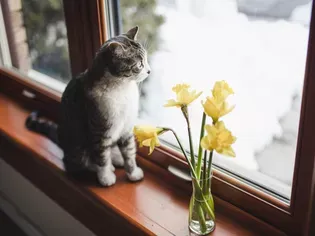Are Daffodils Poisonous to Cats?
Updated on 04/26/24

Unlocking the Enigma: Are Daffodils Poisonous to Cats?
As avid gardeners and dedicated pet owners, we cherish our feline companions and strive to provide them with a safe and healthy environment. However, amidst the vibrant tapestry of our gardens, lurks a potential threat—the enigmatic daffodil.
Daffodils: A Double-Edged Sword
Daffodils, with their cheerful trumpet-shaped blooms, herald the arrival of spring, adding a splash of color to our gardens. Yet, beneath their vibrant exterior lies a hidden danger: they contain toxic substances known as lycorine and narcissus alkaloid.
Lycorine and Narcissus Alkaloid: The Culprits Behind Feline Distress
Lycorine is a potent alkaloid that primarily affects the gastrointestinal system. Ingestion can lead to a cascade of unpleasant symptoms, including:
* Vomiting
* Diarrhea
* Abdominal pain
* Loss of appetite
* Salivation
* Tremors
Narcissus alkaloid, on the other hand, targets the central nervous system, potentially causing:
* Tremors
* Seizures
* Depression
* Respiratory distress
* Cardiac arrhythmias
Vulnerability Depends on Dose and Species
The severity of daffodil poisoning in cats depends on several factors, including:
* Quantity ingested: A small nibble may cause mild symptoms, while consuming a larger amount can lead to life-threatening consequences.
* Species: Some daffodil varieties contain higher concentrations of toxins than others. For example, the common yellow daffodil (Narcissus pseudonarcissus) is more toxic than the paperwhite daffodil (Narcissus tazetta).
Examples of Poisoning Incidents
Unfortunately, daffodil poisoning is not uncommon among cats. Here are a few real-life examples:
* Case 1: A curious 10-month-old kitten ingested several daffodil leaves and developed severe vomiting, diarrhea, and lethargy. Prompt veterinary intervention and supportive care led to a full recovery.
* Case 2: A 7-year-old cat gnawed on daffodil bulbs, resulting in seizures and cardiac arrhythmias. Despite aggressive treatment, the cat sadly succumbed to the toxicity.
Prevention is Paramount
Preventing daffodil poisoning in cats is crucial. Here are some proactive measures you can take:
* Avoid planting daffodils: If possible, opt for daffodil-free gardens to eliminate the risk altogether.
* Supervise outdoor cats: Monitor your cats closely when they're outside, especially during daffodil blooming season.
* Protect daffodils: If you insist on growing daffodils, place them in areas inaccessible to cats, such as hanging baskets or raised planters.
* Educate neighbors: Inform neighbors about the potential dangers of daffodils to cats and encourage them to take precautions.
Immediate Action in Case of Ingestion
If you suspect your cat has ingested daffodils, seek veterinary attention immediately. Time is of the essence, as prompt treatment can significantly improve the chances of a positive outcome.
Conclusion
While daffodils add beauty to our gardens, it's imperative to be aware of their potential toxicity to cats. By understanding the risks, taking preventive measures, and responding swiftly in case of ingestion, we can ensure our feline companions remain safe and healthy amidst the vibrant blooms of spring.
Explore More Pets

Cat Behavior Problems
How to Stop Aggression in Kittens

Long-Haired Cat Breeds
Siberian Cat: Breed Profile, Characteristics, & Care

Cat Behavior Problems
How to Stop Kittens From Scratching and Biting

Long-Haired Cat Breeds
Turkish Angora: Cat Breed Profile, Characteristics & Care

Basic Training
How to Socialize Your Kitten

Short-Haired Cat Breeds
Cute Pictures & Facts About Calico Cats & Kittens

Litter Box Training
Training Your Kitten to Use the Litter Box

Long-Haired Cat Breeds
10 Fun Facts About White Cats